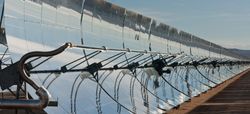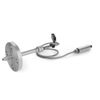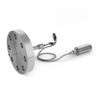Energía renovable
Discover how to monitor pressure in CSP (Concentrated Solar Power) systems
Pressure transducers for pressure control in CSP plants
The pressure transducers of the Gefran CSP series are specifically designed for use in concentrated solar power plants, where thermal fluids reach high temperatures.
These sensors guarantee precise pressure measurements even in the presence of viscous fluids (such as molten salts), ensuring stability and durability over time.
The process
In CSP systems, solar energy is concentrated by mirrors (linear parabolic collectors) onto an absorber tube placed in the focus of the parabola. The heat transfer fluid flowing inside the absorber tube can store and transport heat.
Through a heat exchanger, the energy collected can be used to:
- feed industrial processes;
- generate high pressure steam;
- drive turbines for the production of electricity.
Main components of the CSP system:
- Reflective mirrors, often made of PET and silver film, so lighter and more resistant than glass mirrors;
- Absorber tube, composed of layers of steel and ceramic to ensure high thermal properties;
- Heat transfer fluid, generally a mixture of molten salts, which can operate in a wide range of temperatures because its solidification point is lower compared to traditional fluids;
- Support frame, which ensures mechanical stability.
CSP Technologies
Concentrated Solar Power (CSP) systems are classified according to the type of solar collection they use. The main configurations include:
- Linear Fresnel reflectors
- Central receiver (solar tower)
- Parabolic dish
- Parabolic trough
Currently, parabolic troughs are the most common commercially, but tower systems are becoming increasingly widespread because of their scalability and performance.
Integration with a Thermal Energy Storage (TES) system transforms CSP into a technology that can provide energy even in the absence of sun, overcoming the limits of intermittent renewables such as photovoltaic and wind power.
Advantages of the CSP-TES system:
- Continuous supply of high value electrical or thermal energy
- Reduction in the use of expensive, polluting generators powered by fossil fuels
- Supply of auxiliary services to the electricity grid (regulation, rotating reserves, etc.)
- Ability to respond quickly to peak energy demand
The benefits of the product
To measure pressure in high-temperature heat-transfer fluids, it is necessary to use sensors designed for extreme conditions.
The Gefran pressure transmitters of the CSP family are designed to meet the stringent application requirements of these systems. The main and most important feature of these sensors is their ability to measure the pressure of a viscous fluid at high temperature.
Their main technical characteristics include:
- Pressure measurement at temperatures up to 600°C
- Hydraulic transmission of pressure via incompressible liquid (NaK – Sodium/Potassium)
- Sensitive element that uses a Wheatstone bridge strain gauge with thick film technology
- Robust design with rigid stem and flexible sheath, which means the electronic zone can be remote
- Flange attachment, for a stable and secure connection to the process
These features make Gefran sensors ideal for complex systems and thermally challenging environments.
Thick film on steel technology
The Gefran sensors of the CSP series employ the “thick film” on steel technology, which ensures reliability and robustness over time.
Using the screen printing process, the following elements are deposited on the steel membrane:
- Insulating layers (dielectric)
- Conductive layer (cermet)
- Resistive layer for the Wheatstone Bridge
Through a heat treatment divided into several phases, which include reaching a temperature of 900°C, the different layers are consolidated with the measuring membrane, ensuring robustness, stability and accuracy in sensor readings over the long term.
The thickness of the membrane determines the measurement range, adapting to fluid pressures under complex operating conditions.
Installation
Proper installation is crucial for the reliable operation of the pressure sensor.
Practical tips:
- Do not install the sensor tip directly into the main tube: it is preferable to use a piezometric deflection branch to avoid interference with the direct flow.
- Avoid insulation of the sensor stem: thermal insulation should be limited to the area under the flange, leaving the stem uncovered to reduce unwanted heat transfer.
These precautions reduce the risk of thermal drift and help keep the sensor stable and accurate over time.
Temperature transducers for CSP
Temperature measurement is equally important in the process management of CSP systems, both for thermal efficiency and operational safety.
Depending on specific needs, the following are available:
- Thermocouples
- Thermoresistors
Both technologies allow direct or indirect measurements, and sensors can be installed inside or outside the absorber tube.
In particular, different types of detection are adopted depending on the specific need. Therefore, thermocouples or indirect thermoresistors, such as collar-mounted TC/TRs, can be used instead of TC/TR PADs.
Measurements in direct contact with the fluid are managed through well solutions.
Elements typically used in the CSP field are built in two ways: with ceramic insulators and with mineral oxide (MgO). All types of TC/TR have versions with passive signal TC J/K, or PT100, rather than amplified with 4-20mA signal. Accuracy class 1 DIN, 1/2 DIN, 1/3 DIN, 1/5 DIN and 1/10 DIN in accordance with IEC 751-DIN 43760 for thermoresistors and three tolerance classes 1, 2 and 3 in accordance with IEC 60584-2 for thermocouples.



